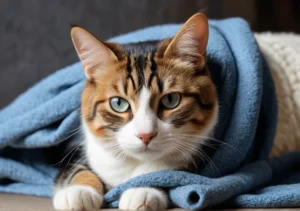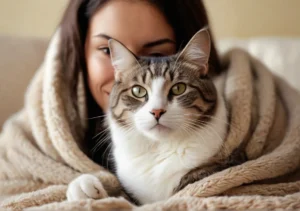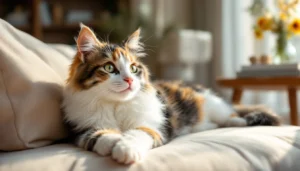Have you ever noticed your cat kneading on a soft blanket, almost as if they’re making bread? This adorable behavior, known as making muffins, is a common yet intriguing feline habit that many cat owners have observed. Why do cats engage in this cute and seemingly purposeless activity? Let’s explore the fascinating reasons behind why cats make muffins on blankets.
The Comforting Act of Kneading
Have you ever wondered why your cat kneads on blankets or soft surfaces? This behavior actually stems from their kittenhood when they would knead their mother’s belly to stimulate milk flow. Kneading helps cats feel comfortable and secure, as it reminds them of their formative years and the warmth and safety associated with nursing. So, the next time you see your furry friend making muffins on your favorite blanket, know that it’s their way of seeking comfort and relaxation.
Scent Marking and Territory
When your cat kneads, they’re not just making bread – they’re also marking their territory. Cats have scent glands in their paws, so when they knead on blankets or furniture, they leave behind their scent as a way to claim ownership of that specific area. This behavior helps them establish familiarity and security within their environment, creating a sense of belonging and ownership. So, the next time you find little paw prints on your cozy blanket, remember that it’s your cat’s way of saying, “This is mine!”
Extra Insight: Strengthening Bonding
Kneading isn’t just about comfort and territory – it can also strengthen the bond between you and your cat. When your furry friend kneads on your lap or beside you, they are showing trust and affection. By reciprocating with gentle pets and cuddles, you can further enhance the bond between you and your feline companion. So, next time your cat starts making muffins, embrace the moment and enjoy this special connection.
Stress Relief and Relaxation
Have you ever noticed your cat kneading on a soft blanket, almost like they’re making little muffins? This behavior is not just adorable; it also serves a practical purpose for our feline friends. Kneading is a natural instinct that cats exhibit, often as a way to alleviate stress and anxiety. The rhythmic motion of kneading is thought to be calming and soothing for cats, similar to how we might find comfort in activities like knitting or squeezing a stress ball. So, the next time you see your cat making muffins on a blanket, know that they are simply trying to unwind and relax in their own unique way.
Mimicking Nursing Behaviors
If you ever wonder why your adult cat still engages in kneading behaviors, consider it as a throwback to their kitten days. When kittens nurse from their mother, they use their paws to massage the mammary glands, stimulating milk flow. This instinct to knead persists into adulthood, with cats associating the action with feelings of comfort and security. This behavior can be especially pronounced when your cat is feeling anxious or in need of reassurance. So, the next time your cat makes muffins on your favorite blanket, remember that they are simply looking for a sense of safety and contentment in the world around them.
Additional Unique Insight: Cats may also knead blankets or other soft surfaces as a way to mark their territory with the scent glands located in their paws, making the area feel more familiar and comforting to them.
Remember, understanding why cats make muffins on blankets can deepen your connection with your feline companion and provide insight into their emotional well-being.
Happy Hormones and Endorphins
When cats knead on blankets, it’s not just a random behavior – it actually serves a purpose! This adorable act triggers the release of happy hormones and endorphins in our feline friends, promoting their overall well-being and contentment. So next time you catch Fluffy making muffins on your favorite throw, remember they’re not just trying to annoy you – they’re actually boosting their mood!
Playful Engagement and Exercise
Have you ever noticed how cats get into a rhythm while kneading on blankets? That’s because this repetitive motion can be a form of playful engagement and light exercise for them. It keeps them entertained and physically active, which is essential for their health and happiness. So, let them keep kneading away for some fun and fitness!
Additional Unique Insight or Angle:
Cats also knead on blankets as a way to mark their territory with scent glands located in their paw pads. This behavior helps them feel secure and at home in their environment. So, the next time your cat is making muffins on your bedspread, know that they’re not only seeking comfort but also marking their presence in a familiar space.
Blanket Material Preferences
Cats often enjoy kneading on blankets, a behavior reminiscent of kneading dough. This behavior is rooted in their instincts from kittenhood, as kittens knead their mother’s belly to stimulate milk flow. When it comes to blanket material preferences, cats may have varying tastes. Some cats prefer soft and fluffy blankets, while others may like knitted or textured fabrics. The choice of material could be influenced by the texture and scent of the blanket. Fabrics like fleece, wool, or even faux fur might be particularly appealing to your feline friend.
Understanding your cat’s preference for specific blanket materials can help you provide them with a comfortable space to knead and relax. Consider offering a variety of blankets with different textures to see which one your cat prefers. Observing your cat’s behavior can provide valuable clues about their blanket material preferences.
Encouraging and Discouraging Kneading
If you enjoy your cat’s kneading behavior and want to encourage it, you can create a cozy spot with their favorite blanket where they feel safe and relaxed. Encouraging this behavior can strengthen the bond between you and your cat, providing them with a sense of comfort and security. Offering positive reinforcement, such as gentle pets and soothing words, can also encourage your cat to continue kneading on their blankets.
On the other hand, if your cat’s kneading becomes too rough or bothersome, you may want to discourage this behavior. Providing a scratching post or a designated kneading area with a similar texture to their favorite blanket can redirect their attention. Avoid scolding or punishing your cat for kneading, as this can cause stress and anxiety.
Tips for Encouraging and Discouraging Kneading:
- Encourage: Provide a designated spot with a favorite blanket
- Encourage: Offer gentle pets and soothing words as positive reinforcement
- Discourage: Redirect attention to a scratching post or similar texture
- Discourage: Avoid scolding or punishing your cat for kneading behavior
Remember, understanding your cat’s behavior and preferences is key to fostering a happy and healthy relationship with your feline companion.
Fun Feline Facts
Did you know that cats making muffins on blankets is a behavior rooted in their instinct from kittenhood? Kneading, as it’s officially known, stems from a kitten’s need to stimulate milk flow from their mother while nursing. This charming habit carries over into adulthood, serving as a comforting and soothing behavior for cats. The rhythmic motion of kneading on soft surfaces like blankets can help cats relax and feel safe. So, the next time your furry friend is making muffins on your favorite throw, remember it’s a natural instinct that brings them joy and contentment.
Bonus: DIY Cat-Friendly Blanket
If you want to encourage your cat’s kneading behavior in a designated spot, consider creating a special blanket just for them. Choose a soft and cozy fabric that your cat enjoys and place it in a quiet, comfortable corner of your home. Sprinkle a few drops of catnip on the blanket to attract your cat and encourage them to knead away. By providing a dedicated space for your cat to make muffins, you’re not only giving them a sense of security but also protecting your furniture from those sharp claws. Your feline friend will thank you for their very own kneading paradise!
Uncover the captivating reasons behind why cats make muffins on blankets and gain a deeper appreciation for this charming behavior that adds to the unique personality of our feline friends.
Alex, a passionate animal lover, has experience in training and understanding animal behavior. As a proud pet parent to two dogs and three cats, he founded AnimalReport.net to share insights from animal experts and expand his knowledge of the animal kingdom.




